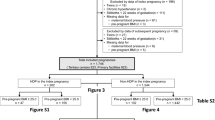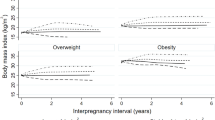Abstract
Objective:
To examine the impact of change in body mass index (BMI) during pregnancy on the incidence of gestational hypertension/preeclampsia.
Study Design:
This is a retrospective cohort study using linked California birth certificate and discharge diagnosis data from the year 2007. Adjusted odds ratios (aOR) and 95% confidence intervals (CI) were calculated for the outcome of gestational hypertension/preeclampsia, as a function of a categorical change in pregnancy BMI: BMI loss (<−0.5), no change (−0.5 to 0.5), minimal (0.6 to 5), moderate (5.1 to 10) and excessive (>10). The impact of change in pregnancy BMI was evaluated for the entire cohort and then as a function of prepregnancy BMI category. Women with no change in pregnancy BMI served as the reference group.
Result:
The study population consisted of 436 414 women with singleton gestations. Overall, women with excessive BMI change had a nearly twofold increased odds of gestational hypertension/preeclampsia (aOR=1.94; 95% CI=1.72 to 2.20). By prepregnancy BMI class, overweight and obese women who had a moderate change in pregnancy BMI also had increased odds of developing gestational hypertension/preeclampsia with aOR ranging from 1.73 to 1.97.
Conclusion:
Regardless of prepregnancy BMI category, women with excessive BMI change have a higher chance of developing gestational hypertension/preeclampsia. Overweight and obese women with moderate BMI change may also be at increased risk.
This is a preview of subscription content, access via your institution
Access options
Subscribe to this journal
Receive 12 print issues and online access
$259.00 per year
only $21.58 per issue
Buy this article
- Purchase on Springer Link
- Instant access to full article PDF
Prices may be subject to local taxes which are calculated during checkout

Similar content being viewed by others
References
ACOG Committee on Practice Bulletins—Obstetrics. ACOG practice bulletin. Diagnosis and management of preeclampsia and eclampsia. Number 33. Obstet Gynecol 2002; 99: 159–167 . Reaffirmed 2012.
Funai EF, Paltiel OB, Malaspina D, Friedlander Y, Deutsch L, Harlap S . Risk factors for pre-eclampsia in nulliparous and parous women: the Jerusalem perinatal study. Paediatr Perinat Epidemiol 2005; 19 (1): 59–68.
Ray JG, Vermeulen MJ, Schull MJ, Redelmeier DA . Cardiovascular health after maternal placental syndromes (CHAMPS): population-based retrospective cohort study. Lancet 2005; 366: 1797–1803.
Gofton EN, Capewell V, Natale R, Gratton RJ . Obstetrical intervention rates and maternal and neonatal outcomes of women with gestational hypertension. Am J Obstet Gynecol 2001; 185: 798–803.
Eskenazi B, Fenster L, Sidney S . A multivariate analysis of risk factors for preeclampsia. JAMA 1991; 266 (2): 237–241.
North RA, McCowan LM, Dekker GA, Poston L, Chan EH, Stewart AW et al. Clinical risk prediction for pre-eclampsia in nulliparous women: development of model in international prospective cohort. BMJ 2011; 342: d1875.
Sibai BM, Lindheimer M, Hauth J, Caritis S, VanDorsten P, Klebanoff M et al. Risk factors for preeclampsia, abruptio placentae, and adverse neonatal outcomes among women with chronic hypertension. National Institute of Child Health and Human Development Network of Maternal-Fetal Medicine Units. N Engl J Med 1998; 339 (10): 667–671.
Cedergren M . Maternal morbid obesity and the risk of adverse pregnancy outcome. Obstet Gynecol 2004; 103: 219–224.
Usha Kiran TS, Hemmadi S, Bethel J, Evans J . Outcome of pregnancy in a woman with increased body mass index. BJOG 2005; 112: 768–772.
Cnattingius S, Bergstrom R, Lipworth L, Kramer M . Prepregnancy weight and the risk of adverse pregnancy outcomes. N Engl J Med 1998; 338: 147–152.
Gaillard R, Steegers E, Hofman A, Jaddoe V . Associations of maternal obesity with blood pressure and the risks of gestational hypertensive disorders. The Generation R Study. J Hypertens 2011; 29: 937–944.
Sibai BM, Gordon T, Thom E, Caritis SN, Klebanoff M, McNellis D et al. Risk factors for preeclampsia in healthy nulliparous women: a prospective multicenter study. The National Institute of Child Health and Human Development Network of Maternal-Fetal Medicine Units. Am J Obstet Gynecol 1995; 172 (2 Pt 1): 642–648.
Chung JH, Melsop KA, Gilbert WM, Caughey AB, Walker CK, Main EK . Increasing pre-pregnancy body mass index is predictive of a progressive escalation in adverse pregnancy outcomes. J Matern Fetal Neonatal Med 2012; 25 (9): 1635–1639.
Swank ML, Caughey AB, Main EK, Melsop KA, Gilbert WM, Chung JH . The Impact of change in pregnancy body mass index on cesarean delivery. J Matern Fetal Neonatal Med 2013 e-pub ahead of print.
World Health Organization. The WHO Global InfoBase. Available at https://apps.who.int/infobase . Accessed on 2/18/2013.
Department of Health and Human Services Centers for Disease Control and Prevention (CDC). Healthy Weight; About BMI for Adults. Available at http://www.cdc.gov/healthyweight/assessing/bmi/adult_bmi/index.html . Accessed 4/22/2013. Body Measurements http://www.cdc.gov/nchs/fastats/bodymeas.htm Accessed 3/10/2013.
Institute of Medicine. Weight Gain During Pregnancy: Reexamining the Guidelines. National Academies Press: Washington, DC, USA, 2009 Available at http://www.iom.edu/Reports/2009/Weight-Gain-During-Pregnancy-Reexamining-the-Guidelines.aspx . Accessed 2/18/2013.
Sibai BM, Ewell M, Levine RJ, Klebanoff MA, Esterlitz J, Catalano PM et al. Risk factors associated with preeclampsia in healthy nulliparous women. The calcium for preeclampsia prevention (CPEP) study group. Am J Obstet Gynecol 1997; 177: 1003–1010.
Fortner RT, Pekow P, Solomon CG . Prepregnancy body mass index, gestational weight gain, and risk of hypertensive pregnancy among Latina women. Am J Obstet Gynecol 2009; 200: 167.e1–167.e7.
Johnson J, Clifton RG, Roberts JM, Myatt L, Hauth JC, Spong CY et al. Pregnancy outcomes with weight gain above or below the 2009 Institute of Medicine Guidelines. Obstet Gynecol 2013; 121 (5): 969–975.
Macdonald-Wallis C, Tilling K, Fraser A, Nelson SM, Lawlor DA . Gestational weight gain as a risk factor for hypertensive disorders of pregnancy. Am J Obstet Gynecol 2013; 209 (1): e1–e16.
American College of Obstetricians and Gynecologists. Obesity in Pregnancy ACOG Committee Opinion No. 549 (Replacing Committee Opinion No. 315, September 2005) Obstet Gynecol 2013; 121: 213–217.
Wolf M, Kettyle E, Sandler L, Ecker JL, Roberts J, Thadhani R . Obesity and preeclampsia: The potential role of inflammation. Obstet Gynecol 2001; 98: 757–762.
Thorsdottir I, Torfadottir JE, Birgisdottir BE, Geirsson RT . Weight gain in women of normal weight before pregnancy complications in pregnancy or delivery and birth outcome. Obstet Gynecol 2002; 99 (5 Pt 1): 799–806.
Marshall NE, Guild C, Cheng YW, Caughey AB, Halloran DR . Maternal superobesity and perinatal outcomes. Am J Obstet Gynecol 2012; 206 (417): e1–e6.
Engstrom JL, Paterson SA, Doherty A, Trabulsi M, Speer KL . Accuracy of self-reported height and weight in women: an integrative review of the literature. J Midwifery Womens Health 2003; 48: 338–345.
Brunner Huber LR . Validity of self-reported height and weight in women of reproductive age. Matern Child Health J 2007; 11: 137–144.
Acknowledgements
This research was presented at the 33rd Annual Scientific Meeting of the Society for Maternal Fetal Medicine, San Francisco, CA, USA, 14 to 16 February 2013. This project was supported by Title V funds received from the California Department of Public Health: Maternal, Child, and Adolescent Health Division. Analysis, interpretation or conclusions reached are those of the authors and not the state of California. No financial support was received for this report. However, Title V funds were received from the California Department of Public Health: Maternal, Child, and Adolescent Health Division to develop the data set by the California Maternal Quality Care Collaborative.
Author information
Authors and Affiliations
Corresponding author
Ethics declarations
Competing interests
The authors declare no conflict of interest.
Appendix I
Appendix I
Rights and permissions
About this article
Cite this article
Swank, M., Caughey, A., Farinelli, C. et al. The impact of change in pregnancy body mass index on the development of gestational hypertensive disorders. J Perinatol 34, 181–185 (2014). https://doi.org/10.1038/jp.2013.168
Received:
Revised:
Accepted:
Published:
Issue Date:
DOI: https://doi.org/10.1038/jp.2013.168
Keywords
This article is cited by
-
Trajectories of sleep quality and associations with excessive gestational weight gain during pregnancy
Sleep and Biological Rhythms (2020)
-
The association between gestational weight gain z-score and stillbirth: a case-control study
BMC Pregnancy and Childbirth (2019)
-
First-Trimester Inflammatory Markers for Risk Evaluation of Pregnancy Hypertension
The Journal of Obstetrics and Gynecology of India (2018)
-
Pre-pregnancy BMI, gestational weight gain and risk of preeclampsia: a birth cohort study in Lanzhou, China
BMC Pregnancy and Childbirth (2017)
-
Racial/Ethnic Differences in Labor Outcomes with Prostaglandin Vaginal Inserts
Journal of Racial and Ethnic Health Disparities (2015)



